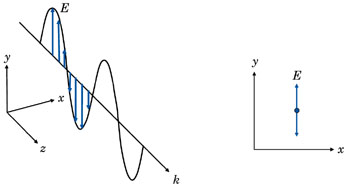Optipedia • SPIE Press books opened for your reference.
Polarization
Excerpt from Field Guide to Optical Lithography
The direction of the electric field of an electromagnetic wave, and how that direction varies in time or space, is called its polarization. Since an electromagnetic wave travels through time and space, there are two useful and equivalent ways of looking at the direction of the electric field: the variation of the electric field direction in space at an instant in time, or the variation of the electric field direction in time at a fixed point in space.
The simplest type of polarization is called linear polarization. At an instant in time, the electric field E is always pointing in one direction for all points in space. At one point in space, the electric field changes magnitude sinusoidally through time, but always points in the same direction.

Other types of polarization include circular polarization, elliptical polarization, and random polarization (often called unpolarized).

C. A. Mack, Field Guide to Optical Lithography, SPIE Press, Bellingham, WA (2006).
View SPIE terms of use.

